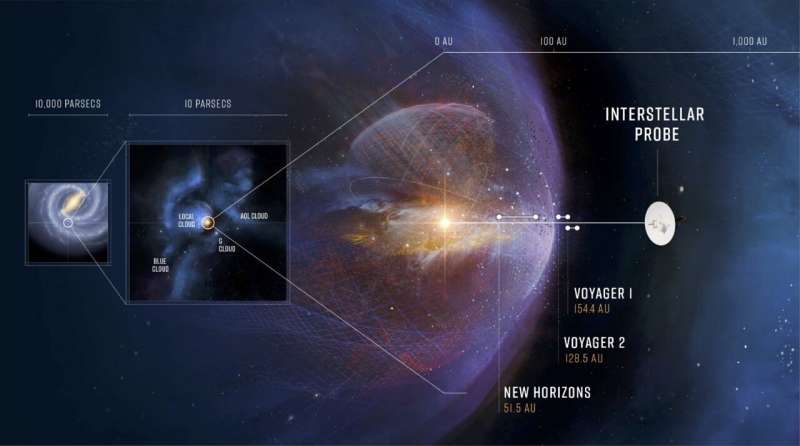A University of Michigan-led study published in Frontiers in Astronomy and Space Sciences provides recommendations to maximize scientific measurements to understand better the size and shape of our home in the heliosphere from the outside.
"Without such a mission, we are like goldfish trying to understand the fishbowl from the inside," said Sarah A. Spitzer, a postdoctoral research fellow at U-M and first author of the study.
"We want to know how the heliosphere protects astronauts and life in general from harmful galactic radiation, but that is difficult to do when we still don't even know the shape of our shield," said Marc Kornbleuth, a research scientist at Boston University and co-author of the study.
According to the study, the best possible exit route is through the side of the heliosphere's tail end.
The interaction of the heliosphere with the local interstellar medium—a material made of plasma, dust, and neutral particles filling the space between astrospheres—forms the shape of our heliosphere and influences the composition of the space environment within the solar system, including near Earth. Currently, models predict the heliosphere could form shapes including spherical, stretched and crescent-shaped.
No final determination of the shape of the heliosphere can be made without additional measurements outside the heliosphere.
"A future interstellar probe mission will be our first opportunity to really see our heliosphere, our home, from the outside, and better to understand its place in the local interstellar medium," said Spitzer.
Thus far, the Voyager 1 and 2 spacecraft are the only missions to have potentially left the heliosphere. Now, 46 years after its 1977 launch, the spacecraft is well beyond its intended mission lifetimes and can no longer provide complete plasma measurements necessary for improving our understanding of the heliosphere's boundaries.
A future interstellar probe mission aims to travel beyond the heliosphere to collect samples from the local interstellar medium. A mission concept report from 2021 involving the collaboration of over 1,000 scientists discussed the payload, launch vehicle, and technical aspects of various trajectories. However, this report assumes that a probe trajectory near 45 degrees off the nose of the heliotail, or the front of the sun's directional motion, is optimal.
Challenging this assumption, the research team analyzed the scientific merit for six possible interstellar probe trajectories ranging from noseward to tailward directions. The researchers concluded that a trajectory intersecting the heliospheric flank toward the tailward direction would provide the best perspective on the shape of the heliosphere and maximize scientific outputs.
"If you want to find out how far back your house extends, walking out the front door and taking a picture from the front sidewalk is likely not your best option. The best way is to go out the side door so you can see how long it is from front to back," said Kornbleuth.
Further, models suggest that interstellar plasma may be injected directly into the heliosphere through the tail, providing an opportunity to sample interstellar plasma both within and beyond our heliosphere. To better understand the heliosphere's interaction with the interstellar medium, the researchers also recommend scientific measurements to be collected on future missions to the far edges of the heliosphere.
"This analysis took a lot of persistence. It started small and grew into a great resource for the community," said Susan Lepri, a professor of climate and space sciences and engineering at U-M and the last author of the study.
In its 46-year journey, the Voyager spacecraft has traveled about 163 astronomical units (15.2 billion miles) away from Earth. Looking ahead, a future interstellar probe will be designed for a 50-year mission intended to travel around 400 astronomical units and may even last to around 1,000 astronomical units, providing an unprecedented view of our heliosphere and the interstellar medium beyond.
More information: Sarah A. Spitzer et al, Complementary interstellar detections from the heliotail, Frontiers in Astronomy and Space Sciences (2024). DOI: 10.3389/fspas.2023.1163519
Provided by University of Michigan College of Engineering



